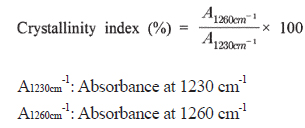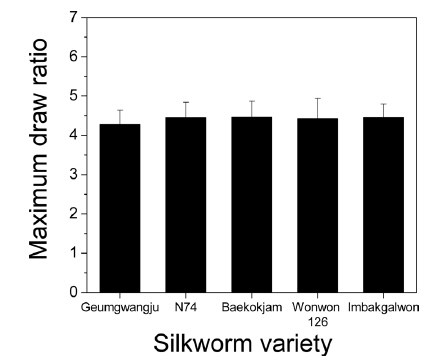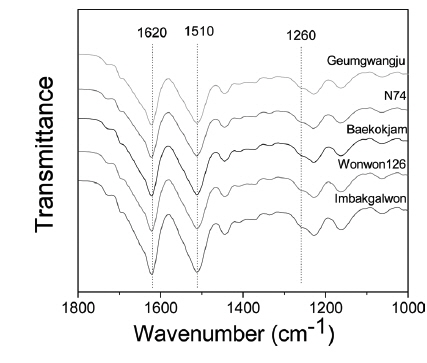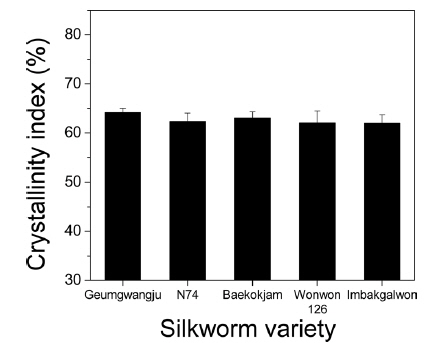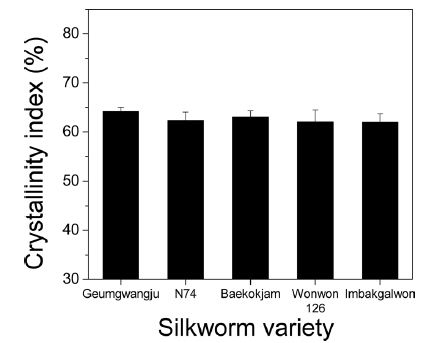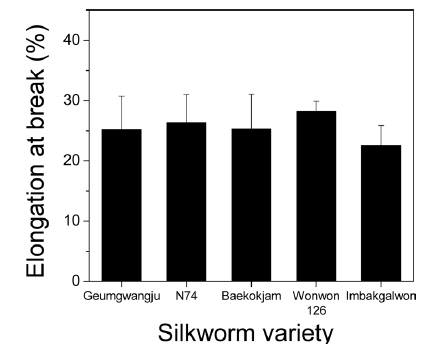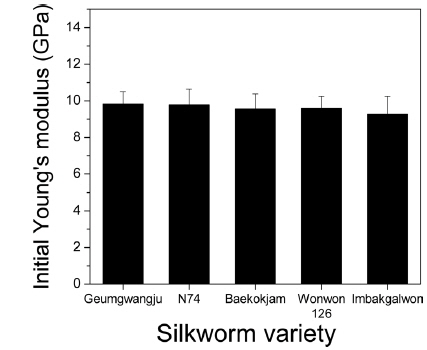



Silk has been an important textile material for a long time due to its excellent luster and touch. Additionally, owing to its compatibility with blood (Sakabe
Natural silk exists as a fiber form with structures and properties as determined by the silkworm. Technology to modify the structure and properties of natural silk fiber is limited. On the other hand, the structure and properties of wet spun silk filament can be changed by controlling the preparation conditions, including the molecular weight (MW) of silk fibroin (SF)(Cho
There are many varieties of
In this study, five different
>
Preparation of regenerated SF
Four different
The method used to degum silk cocoons has been reported elsewhere (Cho
The degummed silk (SF) was dissolved in a ternary solvent containing CaCl2:H2O:EtOH (1:8:2 molar ratio) at 85℃ for 3 min. The liquor ratio was 1:20. The regenerated aqueous SF solutions were obtained by dialyzing the dissolved SF solutions in a cellulose tube (molecular weight cut off [MWCO]) = 12,000–14,000) against circulating purified water for 5 d at room temperature. The regenerated SF solutions were dried at 80℃ and then ground to obtain the regenerated SF powder.
>
Wet spinning of regenerated SF solution
The wet spinning method of SF solution has been reported elsewhere (Chung and Um, 2014). Briefly, the regenerated SFs were dissolved in a 98% formic acid solution to prepare 9% (w/w) SF formic acid dope solutions. The dope solutions were filtered through nonwoven fabric to remove the insoluble particles prior to wet spinning. The regenerated SF filaments were spun using a syringe and syringe pump by extruding the dope solution through a 21-gauge needle (inner diameter = 0.514 mm) into methanol as a coagulation bath. The flow rate of the fiber extrusion was controlled to 20 mL/h. The as-spun SF filaments were left to stand in the coagulant for 1 h and then in purified water for 20 h to allow the solvent (formic acid) to diffuse out completely from the filament prior to drying. Post-drawing of the as-spun SF filament was performed manually at a drawing speed of ca. 15 cm/s at 25℃ in air.
>
Measurement and characterization
A photograph of the wet spun silk filament in the coagulant was obtained using a digital camera (Canon PowerShot A2000 IS, Canon Inc., Japan). The maximum draw ratio was calculated from the ratio of the maximum drawn length of the fiber and length of the as-spun fiber. The drawing of the as-spun SF filament was performed manually with ca. 15 cm/s drawing speed at 25℃ in the air. The fiber lengths were measured at 20 different parts of the filament and the maximum draw ratio was determined from the mean.
The Fourier transform infrared (FTIR; Nicolet 380, Thermo Fisher Scientific, USA) spectra were obtained using the attenuated total reflectance (ATR) method. The crystallinity index was calculated as the intensity ratio of 1260 and 1230 cm−1 from the FTIR spectrum using the following equation (Chung and Um, 2014; Kim and Um, 2014).
To evaluate the mechanical properties of the regenerated SF filaments, stress-strain curves were obtained with a universal testing machine (UTM, OTT-003, Oriental TM, South Korea). The SF filaments tested were 70 mm in length. The tensile tests were performed under standard conditions with a 3 kgf load cell at an extension rate of 10 mm/min and a gauge length of 30 mm. All samples were preconditioned at the standard conditions for more than 1 d. Seven wet spun SF filaments produced by each silkworm variety were tested.
>
Wet spinning and post drawing performances of regenerated SF
Table 1 shows the wet spun feature of 9% regenerated SF solution from different silkworm varieties. Regardless of the silkworm variety, all regenerated SF solutions showed continuous fiber formation without bead formation, indicating the solutions has a good wet spinnability. This suggests that the silkworm variety almost does not affect the fiber formation at the condition used in this study.
[Table 1.] The effect of silkworm varieties on the wet spinnability of regenerated SF solution.
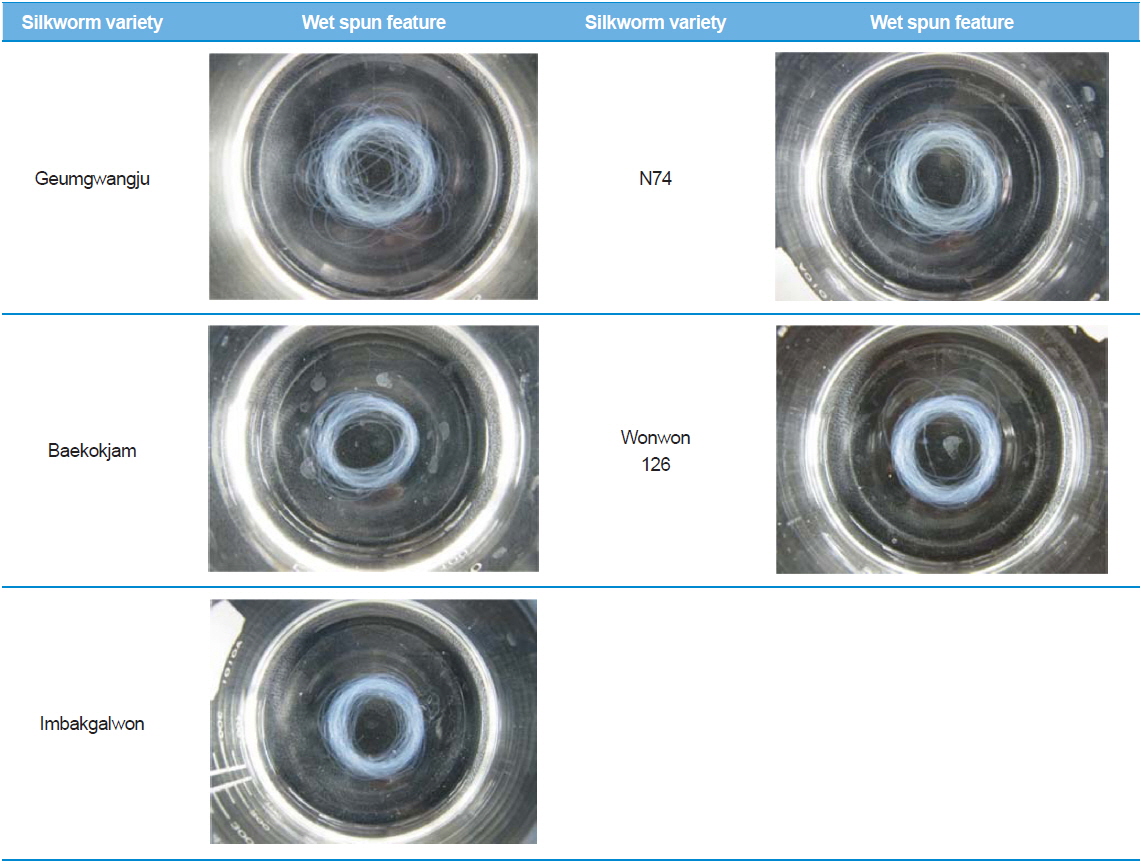
The effect of silkworm varieties on the wet spinnability of regenerated SF solution.
We believe all SF solutions show good fiber formation due to the viscosity of the SF dope solution. More than 80 mPa·s solution viscosity of SF solution results in continuous fiber formation without bead formation (Chung and Um, 2014). Furthermore, Chung
The molecular orientation of wet spun silk filament is very important because it strongly affects the mechanical properties (Um
Fig. 1 shows the maximum draw ratio of wet spun SF filament from different silkworm varieties. Regardless of silkworm variety, all wet spun SF filaments displayed similar maximum draw ratios (4~4.5) indicating that the silkworm variety almost does not influence the post drawing ratio. Kim and Um (2014) reported that the maximum draw ratio of wet spun SF filament is strongly affected by MW and silk concentration. Therefore, the similar maximum draw ratio of SF filament from different silkworm varieties is likely because we used the same (9%) silk concentration for all samples and because there is not a significant difference in the MW between samples.
>
Structure and properties of wet spun regenerated SF filaments
The chemical and physical properties of regenerated silk are affected by its molecular conformation. FTIR can be used to examine the molecular conformation of regenerated silk (Kim
Previous studies have reported that there is a positive relationship between the crystallinity index of as-spun regenerated SF filament and the post drawing performance (i.e. maximum draw ratio) (Kim and Um, 2014; Chung and Um, 2014). Specifically, as the crystallinity index is increased, the maximum draw ratio of the as-spun SF filament increases because a more crystallized fiber can better resist the tensile force, which results in a higher draw ratio. Thus, our results of a similar crystallinity index and maximum draw ratio of wet spun SF filaments (Figs. 1 and 3) are congruent with previous findings.
Fig. 4 shows the tensile strength of regenerated SF filament from different silkworm varieties. Regardless of silkworm variety, the tensile strength of SF filaments was around 300 MPa. In the case of the elongation at break, the regenerated SF filament showed 20~30% (Fig. 5). However, considering the error range of result, the difference between the silkworm varieties is not significant. Initial Young’s modulus of wet spun SF filaments also showed a similar trend in strength and elongation. The wet spun SF filaments had similar Young’s modulus (9~10 GPa) regardless of silkworm variety (Fig. 6).
Chung
The different fabrication characteristics of different silkworm varieties explain the differences in the mechanical properties of regenerated SF film and filament. In the case of cast film, the fabrication process is simple. Regenerated SF film is obtained after complete evaporation of the solvent (formic acid). Chung
Wet spinning has a different fabrication process and thus the mechanical properties of the fiber are affected by additional factors: the uniformity as determined by wet spinnability and the molecular orientation by drawing. Although the regenerated SF has different MWs, the wet spinnability and post drawing performance of regenerated SF were not affected by the silkworm variety, likely because the MW difference among the silkworm variety SF samples was not high enough to result in a measurable difference. This finding is in contrast with previous studies (Chung and Um, 2014) in which they found that MW strongly affects wet spinnability and the post drawing of regenerated SF.
In this study, we examined the wet spinning of SF solutions from five different silkworm varieties. Unlike in regenerated SF film, silkworm variety almost does not affect the wet spinning of the regenerated SF solution nor the structure and properties of the resulting SF filament. This indicates it is difficult to obtain various properties of regenerated SF filament by controlling silkworm varieties, at least, in silkworm varieties used in this study. However, in other viewpoint, this also implies that the structure and properties of wet spun SF filament can be controlled uniformly regardless of silkworm variety. Considering there are more than 300
